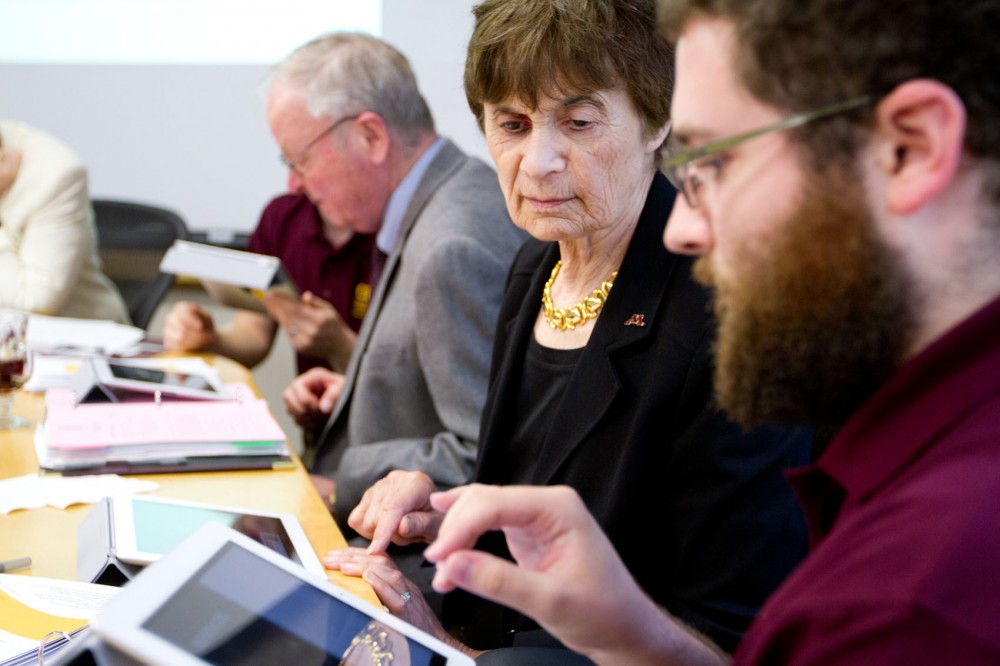Most University of Minnesota Board of Regents meetings don’t involve playing with toys.
But regent members tested iPads in the Educational Planning and Policy Committee’s presentation on e-learning strategies Thursday, which caused them to question how technologically savvy the University is.
According to a recent survey from the Office of Information Technology, the answer is more complicated than it may seem.
Although the number of online classes offered at the University has increased in recent years with the aid of technology, survey results show students and faculty still overwhelmingly prefer in-person courses.
J.D. Walker, OIT manager of research and evaluation, said students and faculty have had consistently positive perceptions of technology since the first survey in 2002.
Rapid changes in technology, however, raised concerns among regents about keeping up with the unknown.
“What if there’s a technology we don’t know about yet?” Regent David McMillan asked the presenters.
Brad Cohen, director of OIT’s Collaborative for Academic Technology Innovation, said the University can be as open to new ideas as possible to combat the rapid changes.
One idea is the Active Learning Classroom. Michelle Driessen, a chemistry associate education specialist, told the regents she will be experimenting with this model in the fall.
The Office of Classroom Management defines ALCs on its website as “student-centered, interactive, integrated, flexible, active learning spaces,” and they have become more popular every year.
ALCs are classrooms — like those in the Science Teaching and Student Services building — that have round tables for group work, microphones, flat-screen TVs and projectors.
The main idea behind them is to provide a “flipped classroom,” Cohen said, where the majority of lecturing is done outside of class via vodcasts, and class time can be spent applying the material.
Faculty responded extremely positively to ALCs in the survey, with nearly 76 percent saying they would like to teach in one in the future.
But for students like sophomore Saif Hassan, the “flipped classroom” can be confusing.
Hassan said he didn’t realize how much work he’d have to do outside of his ALC.
“They always say that you should do that, but now they’re making you,” he said.
The technology-rich space forces instructors to teach courses in ALCs differently. In the survey, 87 percent of faculty said it is important for them to adapt their teaching techniques to the rooms where they teach.
Tech triumphs, difficulties
Catherine Solheim has been teaching a finance class in an ALC since fall 2009. She said she tried teaching as if she were in a lecture hall the first time, and it did not work.
“It does require a rethinking of what you’re doing in a way … because otherwise students can be frustrated,” Solheim said.
But she said it was worth the time it took to restructure her teaching style. Now, she walks around to interact with students more and participates in their group discussions.
Since students are not passively sitting and listening to a lecture, group work is the active learning component of the rooms, Solheim said.
Hassan agreed the ALC was better for that type of learning.
“Group work seems to be more consistent with that format,” he said.
Solheim said she has watched her students grasp the material better doing group work.
“I think learning happens more in interaction,” she said.
Chuck McGill, a teaching specialist in the College of Education and Human Development, teaches future educators how to supplement learning with technology.
For some, an increase in classroom technology use brings more engaging education, but for others it only brings headaches.
Senior Samantha Silver expressed her frustration with technology gone wrong.
“I’ve always had a class period where something goes wrong, and we’ve had to sit there awkwardly for 10 minutes,” she said.
In those situations, McGill said he advises his students to just move on because it is not worth taking the time to fix.
He said it often happens because instructors do not have the time to seek help and end up learning new technologies on their own. The survey results echo McGill’s words — faculty said time required to learn technologies was the No. 1 barrier to using them in education.
Learning technologies is not the only barrier, McGill said — instructors need to make sure they are using technology for the right reasons.
“Don’t just use technology for technology’s sake,” he said. “Make sure that you’re truly integrating.”









